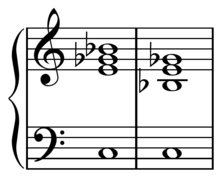- Dominant seventh flat five chord
-
See also: Half-diminished seventh chord
dominant seventh flat five chord Component intervals from root minor seventh diminished fifth (tritone) major third root In music theory, the dominant seventh flat five chord is a seventh chord composed of a root note, together with a major third, a diminished fifth and a minor seventh from root (1, ♮3, ♭5 and ♭7). For example, the dominant seventh flat five built upon C (C7♭5) would be C-E-G♭-B♭. It can be represented by the integer notation {0, 4, 6, 10}. In diatonic harmony, the dominant seventh flat five chord does not naturally occur on any scale degree (as does, for example, the dominant seventh on the fifth scale degree: C7 in F major).
Jazz musicians typically consider the dominant seventh flat five chord to be associated with or built from the seventh mode of the major scale, the Locrian mode. See: chord-scale system and dominant (music).
The dominant seventh flat five may be considered an altered chord, created by diminishing the fifth of a dominant seventh chord, and may use the whole-tone scale[1], as may the augmented minor seventh chord, or the Lydian ♭7 mode[2].
Similarly, a minor seventh flat five chord (m7♭5, also known as a half-diminished seventh chord) is constructed by diminishing the fifth of a minor seventh chord[3]:
- 1 ♭3 ♭5 ♭7
- C E♭ G♭ B♭.
The minor seventh flat five chord occurs in the diminished scale[4] on multiple scale degrees as well as on the seventh degree of the major scale (e.g., B-D-F-A in C major).
Dominant seventh flat five chord table
See also
- Altered scale
- French sixth
Sources
- ^ Manus and Hall (2008). Alfred's Basic Bass Scales & Modes/Alfred's Basic Bass Method, p.22/128. ISBN 0739055844/ISBN 0739055836.
- ^ Berle, Annie (1996). Contemporary Theory And Harmony, p.100-101. ISBN 0825614996.
- ^ Morgen, Howard (1979). Concepts: Arranging for Fingerstyle Guitar, p.161. ISBN 076923075X.
- ^ Manus and Hall (2008), p.23/129.
Chords By type - Major
- Minor
- Dominant
- Dominant seventh flat five
- Diminished
- Half-diminished
- Diminished major
- Minor-major
- Augmented major
- Augmented minor
- Nondominant
- Harmonic seventh chord
- Ninth
- Eleventh
- Thirteenth
- Upper structure
Added
/ omitted- Sixth
- Minor sixth
- Augmented sixth
- Power chord
- Lydian chord
- Seven six chord
By function Secondary- Secondary dominant
- Secondary leading-tone
- Secondary supertonic
With names - Elektra chord
- Farben chord
- Hendrix chord
- Mu chord
- Mystic chord
- Northern lights chord
- Petrushka chord
- Power chord
- Psalms chord
- So What chord
- Spider chord
- Tristan chord
- Viennese trichord
- Dream chord
Other - Common chord (music)
- Mixed interval
- Open chord
- Polychord
- Primary triad
- Quartal and quintal
- Slash chord
- Subsidiary chord
- Synthetic chord
- Tone cluster
Categories:- Altered chords
- Seventh chords
Wikimedia Foundation. 2010.



